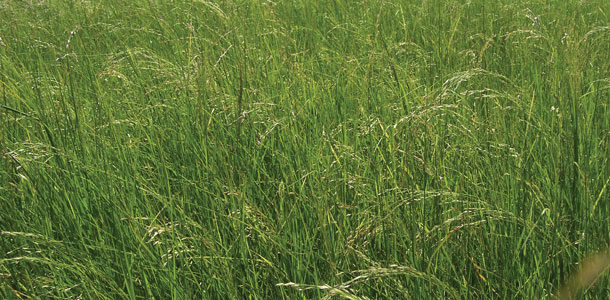However, more options are available that may fit well into current or new practices. One of those options is teff.
Teff is a member of the lovegrass family and has been utilized most extensively in other parts of the world as a grain crop. The mounting interest in the U.S., however, is as a forage crop that has drought tolerance and high palatability.
As more and more producers begin to experience drought or limited water situations, putting teff in the rotation will make a lot of sense for some.
Teff is gaining interest in parts of New Mexico and has found a fit in the small-sized to medium-sized farms located in the Middle Rio Grande Valley area, where statewide drought has made water allocations and distribution uncertain from one year to the next.
Where’s the fit?
Teff has a fit in just about any livestock operation; however, its best fit so far seems to be in the small-bale horse market. This is especially true in New Mexico.
While the state has a large population of dairy cattle, the bulk of the teff hay grown is put up in small bales and sold as a highly palatable horse hay.
The potential for use in the dairy industry, however, is great – especially as more and more dairies are looking for alternative feeds with lower costs and greater sustainability.
Positive experiences and testimonies on dairies in other parts of the West have been reported with this grass, and teff has been successfully incorporated into feeding rations in place of alfalfa.
The primary hay that teff is often compared to is timothy – hence, the early and continued interest as a horse hay. Crude protein, fiber fractions and total digestible nutrients of teff are quite similar to timothy.
In general, teff that is managed and harvested properly will fall into the No. 2 hay range. Early, less-mature cuts may improve this to a No. 1 classification.
Although teff has high total fiber (NDF 50 to 65 percent), which often leads to its lower ranking on commonly used quality scales, lab analyses have indicated that this fiber is highly digestible (NDFD), which means animal performance on teff may be better than what is expected when looking at just fiber quantity alone.
Teff has a great fit into alfalfa rotations. Typical recommendations are to allow for at least one year, preferably two years in between alfalfa stands because of autotoxicity concerns.
During this period, teff can be planted in the late spring, after termination of the old alfalfa stand, and prior to replanting alfalfa in the subsequent late summer or fall.
Depending on planting date and growing season, anywhere from one to four cuttings are possible with teff in the summer.
This scenario allows for another hay crop to be grown in between alfalfa crops while also reducing fertilizer inputs for teff by taking advantage of residual soil nitrogen left over from the previous alfalfa. In fact, teff requires little nitrogen, and all its needs may be met by the alfalfa residual if only one or two cuttings are taken.
Much like the other warm-season annuals, teff can be planted late as an emergency or catch crop – or perhaps when water becomes available late in the season.
This is due to its rapid growth under warm conditions. First cuttings may be as early as 45 days from planting, with 30-day cutting intervals on subsequent cuts.
Teff can also be used to beef up declining alfalfa stands in the last year of production. It can be interseeded into alfalfa after the first cutting once soil temperatures warm sufficiently.
In addition, teff can be used to produce large amounts of forage in areas dominated by cool-season perennial grasses that may experience growth reductions in the heat of the summer.
Drought and limited-water scenarios
Some of the major benefits of teff are its flexibility with planting, drought tolerance and how it can be incorporated into “less-than-ideal” water situations.
A major concern in much of New Mexico is irrigation water allocation. Depending on winter snowpack and reservoir storage levels, water may or may not be available to producers for the entire growing season or in lower amounts.
A common scenario is to have water early and then cut off or reduced in mid-summer if rainfall is not adequate.
Research at NMSU’s Agricultural Science Center at Tucumcari has shown that teff can yield as much forage in the second half of the growing season with about half as much water as commonly put on alfalfa.
Because alfalfa can survive extended periods of little to no irrigation and recover, producers facing water shortages late in the season can focus any water on a crop like teff that may return more forage per inch than alfalfa during hot growing conditions.
This obviously becomes more difficult to manage if water is shut off completely late in the season; however, because teff is more efficient during that time, having some acres planted adds flexibility to the system where there could be at least a moderate amount of forage produced, if sufficient rain occurs, rather than very little or none.
Even in a full allotment year or in conditions where water is not limiting, teff can be a good option for hay growers. Having a diverse crop base and marketing options are beneficial.
Some consumers, particularly horse owners, may prefer grass hay over alfalfa and having some teff hay on hand could expand the number of customers you reach. Planting teff gives the producer a good grass hay option that doesn’t require the long-term commitment of perennial grass systems.
How much yield to expect
Total and per-cutting yields will depend largely on irrigation and rainfall, how early the crop is planted and how long the growing season is.
In central New Mexico, at the NMSU Los Lunas Agricultural Science Center where the average frost-free period is 165 days, we’ve been able to consistently get three cuts and a small clipping on either the front or back end of the season.
Total seasonal hay yields have averaged between 3 and 5 tons per acre (1.5 to 2 tons per acre per cutting) for each of the three years it’s been grown.
These have been back-to-back drought years for much of the region. Similar yields have been observed in other locations in New Mexico over the same period.
Yields as high as 6 to 7 tons per acre are reported in other parts of the country under less-dry growing conditions (e.g., California, Oregon, Wisconsin).
Yield, as well as crude protein content, is greatly influenced by nitrogen fertility. Although teff appears to be nitrogen-use efficient, it does require between 30 and 50 pounds of N per cutting for optimal yields.
Split applications are best, and the first application should be delayed until after growth reaches 2 to 4 inches. Sorghum-sudans and pearl millet are expected to yield more forage than teff under similar growing conditions.
Compared to other warm-season annuals
Although yield may be lower, teff has the added benefit of fewer toxicity concerns compared to sorghums and millets. Nitrate levels have been shown to remain low in moderate-fertilizer situations, and prussic acid is not an issue with teff.
This makes teff a safer option in drought and freeze conditions, although, like sorghum, teff will be killed at first frost. In addition, no negative health issues have been observed in horses consuming teff, unlike sorghums.
In fact, teff has a good balance of nonstructural carbohydrates, fiber and digestible energy, which makes it suitable for obese horses or those with potential for metabolic disorders (e.g., laminitis).
Drying teff hay will be easier because of the fine stems and leaves compared to other annuals. This characteristic also makes for a nice tight bale that typically weighs heavier and will have fewer issues with mold. In beef operations (e.g., cow hay or grazing), however, annuals like sorghum or millet might be preferred because of the greater yield potential compared to teff.
In general, this is true for both hay and pasture. Teff is not as tolerant to grazing and can be easily damaged by hoof traffic or uprooted during grazing. Also, sorghum and pearl millet forages will have more labeled herbicides, and weed control will be easier than in teff.
In summary, teff is a rapidly growing forage that fits well into limited water situations and can be used for practically any class of livestock. Its drought tolerance, high palatability and virtually no toxicity make it much more flexible than other drought-tolerant forages commonly used. FG
Visit New Mexico Foages for more information on teff, specifically establishment and management, or other forages.

Mark Marsalis
Extension Forage Specialist
Extension Plant Sciences Department
New Mexico State University











